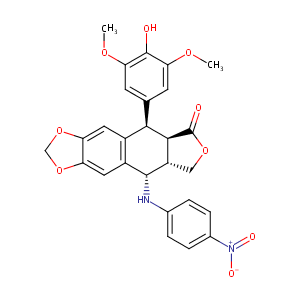Details of the Drug
General Information of Drug (ID: DM10CBF)
| Drug Name |
GL-331
|
||||||||||||||||||||||
|---|---|---|---|---|---|---|---|---|---|---|---|---|---|---|---|---|---|---|---|---|---|---|---|
| Synonyms |
GL-331; UNII-0I81858VSZ; 127882-73-9; 0I81858VSZ; NSC628672; NSC 628672; AC1L3WEV; CHEMBL283631; SCHEMBL5953587; DTXSID40155689; ZINC8652994; 5,8,8a,9-Tetrahydro-5-(4-hydroxy-3,5-dimethoxyphenyl)-9-((4-nitrophenyl)amino)-furo(3',4':6,7)naphtho(2,3-d)-1,3-dioxol-6(5aH)-one, (5R-(5alpha,5abeta,8aalpha,9beta))-; (5R-(5alpha,5abeta,8aalpha,9beta))-5,8,8a,9-tetrahydro-5-(4-hydroxy-3,5-dimethoxyphenyl)-9-((4-nitrophenyl)amino)furo(3',4':6,7)naphtho(2,3-d)-1,3-dioxol-6(5aH)-one
|
||||||||||||||||||||||
| Indication |
|
||||||||||||||||||||||
| Drug Type |
Small molecular drug
|
||||||||||||||||||||||
| Structure |
 |
||||||||||||||||||||||
| 3D MOL | 2D MOL | ||||||||||||||||||||||
| #Ro5 Violations (Lipinski): 1 | Molecular Weight (mw) | 520.5 | |||||||||||||||||||||
| Logarithm of the Partition Coefficient (xlogp) | 3.9 | ||||||||||||||||||||||
| Rotatable Bond Count (rotbonds) | 5 | ||||||||||||||||||||||
| Hydrogen Bond Donor Count (hbonddonor) | 2 | ||||||||||||||||||||||
| Hydrogen Bond Acceptor Count (hbondacc) | 10 | ||||||||||||||||||||||
| Chemical Identifiers |
|
||||||||||||||||||||||
| Cross-matching ID | |||||||||||||||||||||||
Molecular Interaction Atlas of This Drug
 Drug Therapeutic Target (DTT) |
|
||||||||||||||||||||||||||
|---|---|---|---|---|---|---|---|---|---|---|---|---|---|---|---|---|---|---|---|---|---|---|---|---|---|---|---|
| Molecular Interaction Atlas (MIA) | |||||||||||||||||||||||||||
References
